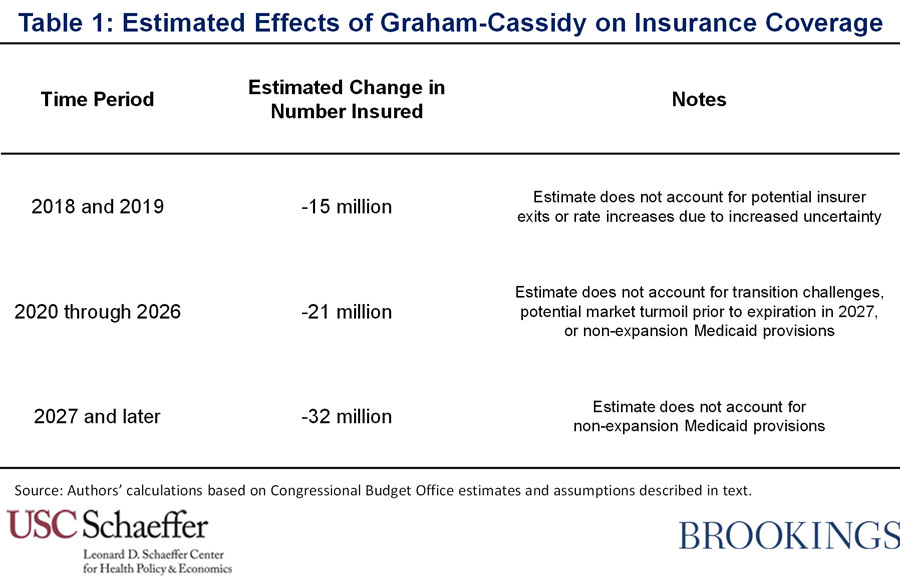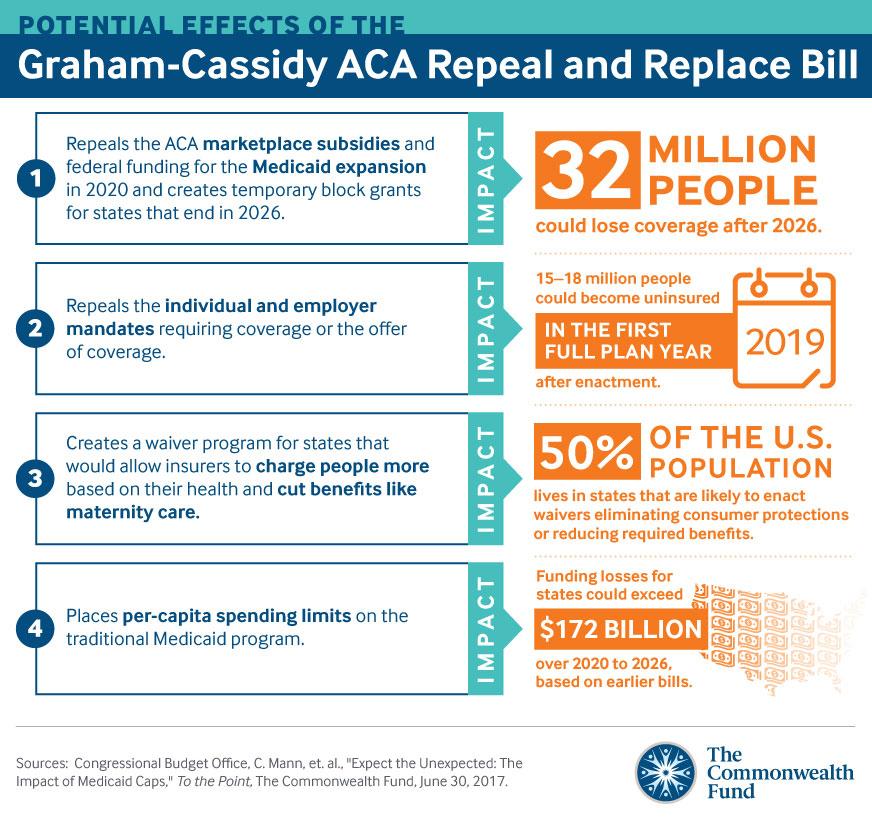UPDATE: 4 different analyses project ~32 MILLION would lose coverage by 2027 under Graham-Cassidy
The Congressional Budget Office stated that they won't be able to provide a full score of the projected 10-year impact of the Graham-Cassidy bill for "at least several weeks". Instead, they expect to provide a partial score, focusing purely on the budget-related stuff necessary to "count" towards Senate reconciliation voting rules "early next week".
What won't be included are some pretty damned important details, like:
- Impact on the federal deficit
- Impact on insurance premiums, and of course...
- Impact on the number of people with health insurance coverage
Unfortunately, Mitch McConnell and Senate Republicans are insisting on squeezing the vote on Graham-Cassidy through within the next 10 days, before the fiscal year ends on Sept. 30th, since that's the only way they have a chance at passing it using 50 votes (after the 30th, they would require 60 votes, which of course they have no chance at getting).
Fortunately, the number crunchers over at the Center for American Progress have once again done the math to figure out just how many people they think would lose coverage by 2027 under Graham-Cassidy. Big shocker: It's a lot of people, around 10% of the entire country:
Graham-Cassidy’s impact on coverage in 2027 would be similar to that of the Obamacare Repeal Reconciliation Act (ORRA), the so-called “repeal and delay” bill that the Senate failed to pass in July. Under both the ORRA and Graham-Cassidy, these three major policies would be in effect a decade from now:
- Repeal of the mandates for individuals to obtain health insurance coverage and large employers to offer insurance
- Elimination of subsidies for nongroup health insurance
- Elimination federal funding for the ACA’s Medicaid expansion
The CBO estimated that the ORRA would have resulted in tens of million more uninsured in 2026. It projects that Medicaid would cover 19 million fewer people and that the individual market, with 23 million fewer people, would nearly disappear. Although the CBO expects that about 11 million more people would have coverage through an employer, the ORRA’s net effect would be 32 million fewer people with coverage in 2026.
Here's what they figure the state-by-state breakout would be:
Read their full report and methodology here. The numbers line up pretty closely to my own "clean repeal" estimates from way back in March.
UPDATE: Right on the heels of the CAP analysis comes a similar projection from the Commonwealth Fund, which doesn't do a state-level breakout but once again comes up with a net increase in the number of uninsured Americans of around 32 million.
Last week, Sens. Lindsey Graham (R–S.C.) and Bill Cassidy (R–La.) unveiled congressional Republicans’ latest bill to repeal and replace the Affordable Care Act (ACA). The Congressional Budget Office (CBO) has indicated that it will not release a score of the bill that includes its effects on insurance coverage for several weeks, but Senate leaders have indicated they will hold a vote without a score. The bill, however, is similar to prior ACA repeal-and-replace bills for which we do have CBO scores. Based on those estimates, it is likely that the bill, if enacted, would lead to a loss of health insurance for at least 32 million people after 2026.
The bill can be boiled down to five key provisions:
- Repeals the ACA marketplace subsidies and federal funding for the Medicaid expansion in 2020.
- Creates a temporary block grant for states that ends in 2026. States can use the funds for a wide range of purposes.
- Repeals the individual and employer mandates.
- Creates a waiver program for states that would allow insurers to charge people more based on their health and cut benefits like maternity care.
- Places per capita spending limits on funding for the traditional Medicaid program.
They also include their own infographic:
UPDATE 9/22/17: Add two more analyses to the pile:
First up, the Brookings Institute:
Based on this analysis, we estimate that the Graham-Cassidy legislation would reduce the number of people with insurance coverage by around 21 million each year during the 2020 through 2026 period. This estimate likely understates the reductions in insurance coverage that would actually occur under the Graham-Cassidy legislation, particularly toward the beginning and end of the seven-year period, because it does not account for the challenges states will face in setting up new programs on the bill’s proposed timeline, the possibility that uncertainty about the program’s future will cause market turmoil toward the end of the seven-year period, or the bill’s Medicaid per capita cap and other non-expansion-related Medicaid provisions. These estimates are, of course, subject to considerable uncertainty, most importantly because predicting how states would respond to the dramatic changes in the policy environment under the Graham-Cassidy proposal is very challenging. What is clear, however, is that the legislation would result in very large reductions in insurance coverage.
The Graham-Cassidy legislation’s adverse effects on insurance coverage are likely to increase after its block grant funding expires at the end of 2026. After that time, the legislation is similar to the “repeal and delay” proposal that the Senate considered in July, which CBO estimated would reduce the number of people with insurance coverage by 32 million people in the long run. Reductions in insurance coverage would likely be somewhat larger under the Graham-Cassidy proposal because of the legislation’s non-expansion related Medicaid provisions, which would further reduce insurance coverage.

And finally, Physicians for a National Health Program:
Health researchers: Graham-Cassidy bill would increase deaths by 41,600 annually
Doctors dub Graham-Cassidy “The Undertaker Full Employment Act”
Physicians and public health researchers Drs. Steffie Woolhandler and David Himmelstein estimate that implementation of the proposed Graham-Cassidy legislation would push an additional 32 million Americans off their health insurance over the next decade, resulting in 41,600 additional deaths in 2027.
Since the Congressional Budget Office could not conduct a timely analysis of the bill before its expected vote, the researchers—who have studied the effects of insurance coverage on health outcomes—analyzed the bill’s impact on insurance coverage and mortality.
"The Graham-Cassidy bill—what we’re calling ‘The Undertaker Full Employment Act’—would cut health coverage by 14 million Americans in 2020, rising to at least 32 million in 2027,” said Dr. Woolhandler, an internist in the South Bronx, Distinguished Professor of Public Health at the City University of New York at Hunter College (CUNY) and lecturer in medicine at Harvard. “That means 18,200 extra deaths in the first year, climbing to 41,600 annually within a decade.”
How to support my healthcare wonkery:
1. Donate via ActBlue or PayPal
2. Subscribe via Substack.
3. Subscribe via Patreon.





